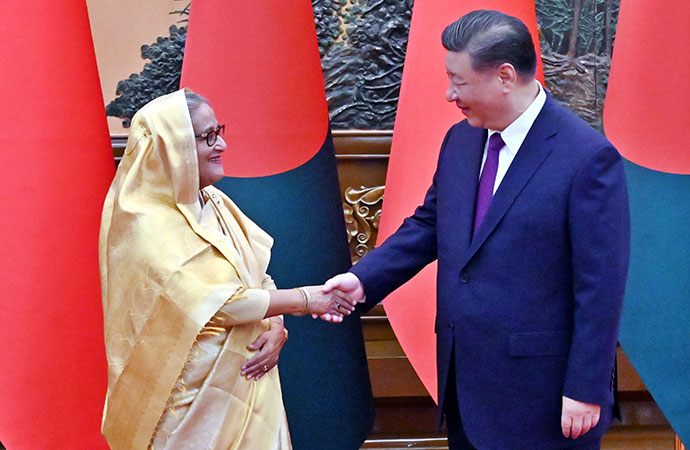Featured 1

Chinese President Xi Jinping (R) shakes hands with Bangladeshi Prime Minister Sheikh Hasina in Beijing, China, July 10, 2024. Photo: PID
Leaders' summits can yield fruits in a variety of ways. What each side is able to get out of them ultimately depends on a combination of factors ranging from the power dynamic between the two states, built up over time, the geopolitics of the day, how each side prepares (this is where the diplomatic corps earn their living), and what can often act as the X-factor: the personal chemistry between the two leaders.
Sheikh Hasina and Xi Jinping have now led their nations for 15 and 12 years in a row respectively. It represents a generation's worth of top-level interactions, by way of their engagements in various forums, interactions at international conferences. Those meetings on the sidelines add up. But as far as bilateral summits go, properly defined, this week's visit to Beijing by the Bangladesh prime minister witnessed the third between the two nations in the Hasina-Xi era, after 2014 (Beijing) and 2016 (Dhaka). Xi had also visited Bangladesh as vice president in 2012, a few short months before ascending to the top position. By now, it should be expected that a sense of familiarity, an understanding of each other's priorities and compulsions, and even an appreciation of the other's limits and ambitions, imbues the personal equation between them.
To the extent that Bangladesh is increasingly viewed on the world stage as the subject of an on-again, off-again tug-of-war between two Asian giants, there is really no scope for the country to perhaps try and exploiting the rivalry between China and India, or play one off against the other, or even to bask in their courtship. Even some international media outlets have fallen prey to this completely wrong impression, of Bangladesh being in this cosy corner of the world where both India and China, the two biggest engines of growth in the world economy for decades to come, are vying for its attention. To the contrary, the reality on the ground tells us stalemates and indecision are more often the order of the day, and the time often lost as a result is from Bangladesh's ledger. There can probably be no better example of this than the two competing visions that have now emerged over how Bangladesh can make the best of the Teesta River and its surrounding ecology.
To be fair, as the years have gone by, the Awami League government in Dhaka has actually done its best not to shy away from the fact that its primal, inviolable commitment remains to India, owing to a number of reasons starting from the birth of the nation, to a shared cultural heritage to geographic realities. To her credit - and Xi will have appreciated this - Sheikh Hasina's administration has chosen to try and articulate this as clearly as possible, instead of beating about the bush and trying to play both corners, as some believe it to be.
We also saw this adhered to in the scheduling of the prime minister's first two bilateral visits abroad, i.e. the visits to Delhi and Beijing that in the end took place in the space of twenty days or so. The pundits and commentators can make of it what they will, but on the back of experience, all that can probably be said with any degree of certainty today is that the greatest danger for Bangladesh may well lie in trying to be too clever in this situation, and trying to make any undue gains out of it. It has to tread with caution, and patience, and always endeavour to make its position clear to its counterparts, in this most intriguing triangle. To that end, the government in Dhaka cannot be faulted for much, in trying to make the best of a difficult situation.

























Leave a Comment
Recent Posts
Curtain rises on 6th National ...
The month-long '6th National Sculpture Exhibition 2024', organ ...
Thailand's sea nomads strive t ...
When Hook was a child, he started his days by jumping off the boat tha ...
Liliums grown in Bagerhat show surprising promise fo ..
Bangladesh’s three divisions brace for rain
Prioritise reconstruction of Gaza, West Bank, Lebano ..
In support of the vision set forth by the CA